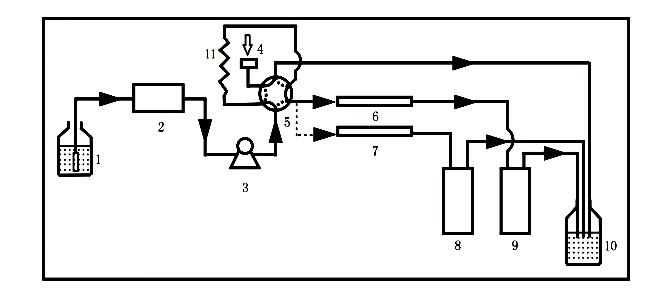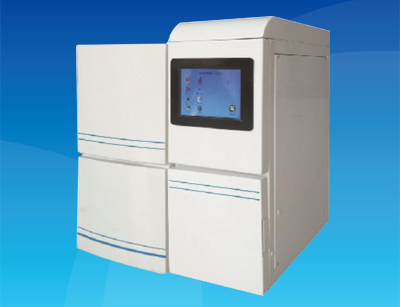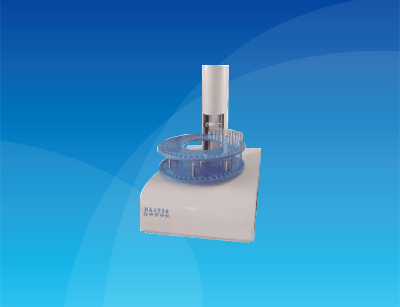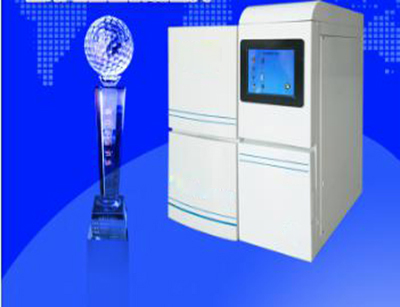on Chromatograph (Mid-end)
THE BASIC STRUCTURE AND PRINCIPLE The IC7000 ion chromatograph is mainly composed of the following components: advection pump positive pressure exhaust system six-port sampling valve chromatographic separation column anion suppressor c...
THE BASIC STRUCTURE AND PRINCIPLE
The IC7000 ion chromatograph is mainly composed of the following components: advection pump, positive pressure exhaust system, six-port sampling valve, chromatographic separation column, anion suppressor, conductance detector, chromatographic data processing system, etc. All types of flow connections use card-type connectors. The schematic diagram of the flow path is as follows:

1, eluent 2, positive pressure exhaust (optional) 3, advection pump 4, inlet 5, six-pass injection valve 6, anion separation column 7, cation separation column (optional) 8, conductivity cell ( Optional) 9, ASCD 10, waste liquid 11, quantitative tube
Advection pump
The role of the advection pump is to allow the eluent to pass through the flow system at a certain flow rate. The instrument's advection pump is built into the mainframe chassis and is a reciprocating double-plunger advection pump. The pump uses a pressure-buffering technology to reduce the flow pulsation. The flow rate can be adjusted in the range of 0.001-9.999 ml/min. Please refer to Chapter 4 for precautions for use of the advective pump.
Positive Pressure Exhaust System (Optional)
The device automatically and continuously eliminates dissolved gases in the eluent. The system is fully automatic and does not require special operations. For details, see Appendix III.
6-way injection valve
The six-way valve of this instrument adopts the universal card sleeve street. This sampling device ensures the pressure resistance of the injection valve. The instrument sample ring is 10ul. Note that when the valve is pulled, it moves faster, otherwise the flow pressure will be too high.
Chromatographic separation column
The ion chromatography column is the most important part of the ion chromatograph. Under the action of the eluent, the components to be tested in the sample are separated one by one in the column and then enter the detector. There is a clear direction sign on the separation column. Be careful not to reverse it. Each separation column has a recommended chromatographic condition such as eluent concentration, flow rate, etc. The user can also explore the most suitable chromatographic conditions based on his actual situation. The principle of ion exchange separation, please refer to Appendix I.
Direct Conductivity Detector (CD)
Conductivity detectors are the most commonly used detectors for ion chromatography. Under certain concentration conditions, the conductance signal generated by the component to be measured in the solution is proportional to its concentration. The function of the conductivity detector is to convert the conductivity signal of the solution into a current signal, which is amplified and output. The instrument uses a 5-pole conductivity cell, which has a high sensitivity; at the same time, a constant temperature device for the conductivity cell is added, which effectively solves the temperature drift and makes the baseline more stable.
Anion Automatic Regeneration Suppressor (AARS)
The function of the suppressor is to reduce the background conductance of the eluent and to increase the conductance of the component to be measured, which greatly improves the sensitivity ofthe conductivity detection. AARS requires no electrolyte and can work continuously. When working, a constant current must be applied to the two poles. The magnitude of the applied current is proportional to its suppression capacity. If the elution intensity exceeds the suppression capacity of the suppressor, the background conductance will rise and the baseline will be unstable. The suppression current of this instrument can be adjusted within the range of 0-100mA. We recommend using 60mA. The working principle of the automatic regeneration suppressor is shown in Appendix II.
Anion Suppression Conductance Cell (ASCD)
ASCD is a module that integrates an anion suppressor and a conductivity cell into one body. This suppression and detection method can make the signal more stable, reduce the baseline drift, and simplify the flow path. Pay attention to the eluent inlet and outlet signs during installation. Instruments equipped with ASCD do not require an additional anion suppressor and conductivity cell.
Chromatographic data processing workstation
The instrument uses a SePu3000 chromatography workstation, an excellent all-Chinese chromatographic analysis software (for details, refer to "SePu Chromatographic Workstation User's Manual").
Main Specifications
● Analysis reproducibility: better than 1% (measured by SO42-)
● Linear correlation coefficient: ≥0.999
● Linear range: ≥103
● Flow range: 0.001~9.999ml/min
● Conductivity cell volume: ≤0.8 ul
●F-、Cl-、NO3-、SO42- and other anions can all be separated from a sample each time
Must condition
● High quality deionized water, conductivity should be less than 1uS/cm
● No strong vibration and strong electromagnetic field interference around the instrument
● Single-phase AC 220V±10%, frequency 50HZ±1%
● Smooth and reliable worktable



